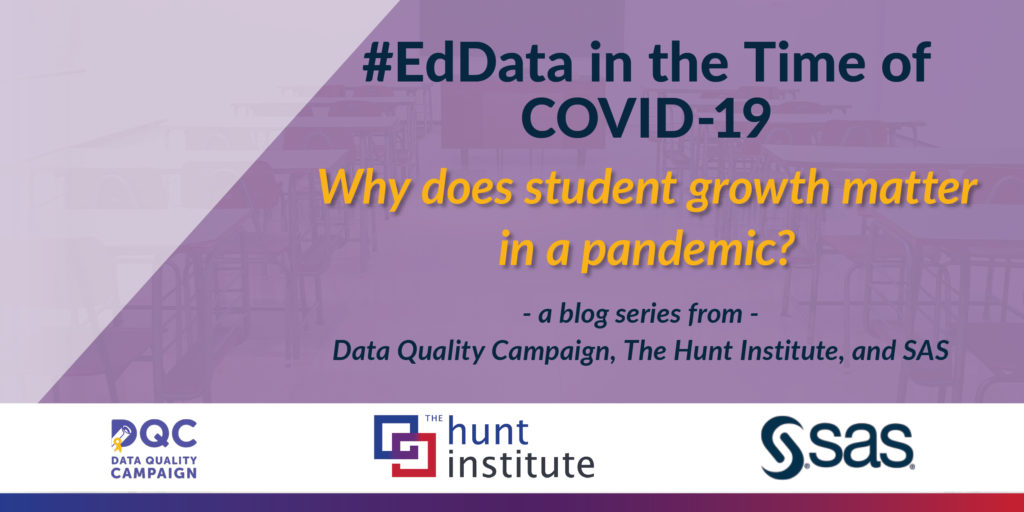

April 8, 2021

As policymakers across the country grapple with how to administer 2021 assessments, The Hunt Institute and Data Quality Campaign have hosted a series of webinars highlighting different aspects of measuring student growth this year. During these webinars, we’ve received many questions—and both organizations have teamed up with SAS to answer them in a series of blog posts. Read more on #EdData in the time of COVID-19 in our first conversation below.
The Hunt Institute: There is no question that COVID-19 has caused our nation’s students to lose precious learning time. McKinsey & Company recently estimated that the average student would lose five to nine months of learning by the end of the 2020-21 school year. The extent of learning loss for students of color may be even greater; McKinsey predicted they would lose an average of six to 12 months of learning, exacerbating pre-existing disparities.
SAS: As we see the light at the end of the tunnel of this pandemic, it’s important that we understand the true impact that the rapid and unexpected changes to our school year had on student learning. Now states are beginning to look towards the end of the 2020–21 school year and deciding how to measure growth over the past two years.
Many states and districts have continued to assess students through benchmark and formative assessments to inform daily practice in the classroom. But there will be significant additional value in statewide summative assessments to truly understand the pandemic’s impact on teaching and learning and on student’s progress towards meeting their academic goals.
Data Quality Campaign: Growth measures are the most comprehensive and equitable tools we have to measure student learning. This data is essential to understand how students are progressing and provide needed supports—particularly for students who may not meet proficiency benchmarks, but are still improving. Growth measures also provide a more detailed picture of student achievement than proficiency measures alone, highlighting educators that are going above and beyond to serve their students.
As we outlined in a brief last summer, state leaders can and should continue to measure student growth in 2021. Having growth data for this year will be crucial to understanding how COVID-related school closures and the shift to online learning affected student progress. State and district leaders need this information to evaluate how schools supported students during this unprecedented year and to plan for continued recovery efforts next year. Teachers and parents also want and deserve information on how the pandemic affected their students; in DQC’s 2020 national parent and teacher polls, conducted in the midst of COVID-19-related school closures, 65 percent of parents and 61 percent of teachers said that they wanted information about student academic growth while schools were closed. The public recognizes the importance of student growth as a measure of student progress—now is not the time for states to give up on it.
SAS: This is one reason why it will be imperative to not only measure proficiency but also measure growth in any state that proceeds with their spring assessment. Measuring student growth using a skip-year model will allow us to see how much progress students have made over the last two years and the impact on different groups of students. Additionally, it could provide insights into exemplar schools and districts that stakeholders might be able to learn from.
The Hunt Institute: Education leaders, policymakers, and the public are rightfully asking how we can best help students catch up, both this summer as well as next school year. The right answer, however, requires that we identify the areas in and extent to which students are struggling, as well as which students are most in need of additional support.
Student performance data – and especially growth data that can show how student achievement changes over time– provide the means by which to make those decisions. Yes, it is time-intensive. But proceeding forward without any real indicator of student need is more so. As Acting Assistant Education Secretary Ian Rosenblum wrote in a letter to education leaders in February, “To be successful once schools have reopened, we need to understand the impact COVID-19 has had on learning and identify what resources and supports students need.”
Tennessee recently passed SB 7001, which provides educators and parents with data from 2020-21 assessments to give information of where Tennessee students are and the supports needed to offset learning loss. We encourage states to consider policies like this so data can be used to benefit schools, educators, students, and families.
Watch our recent webinars on the topic of student growth and register for the third installment of our series with DQC – Thinking Creatively to Evaluate Student Growth.
Using Skip-Year Growth
Policymaker Insights on Skip-Year Growth
REGISTER! Student Growth Now and Into the Future